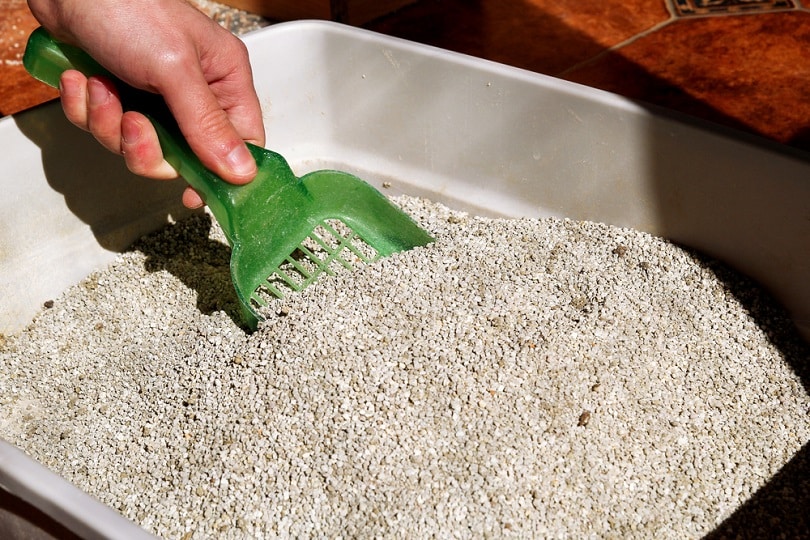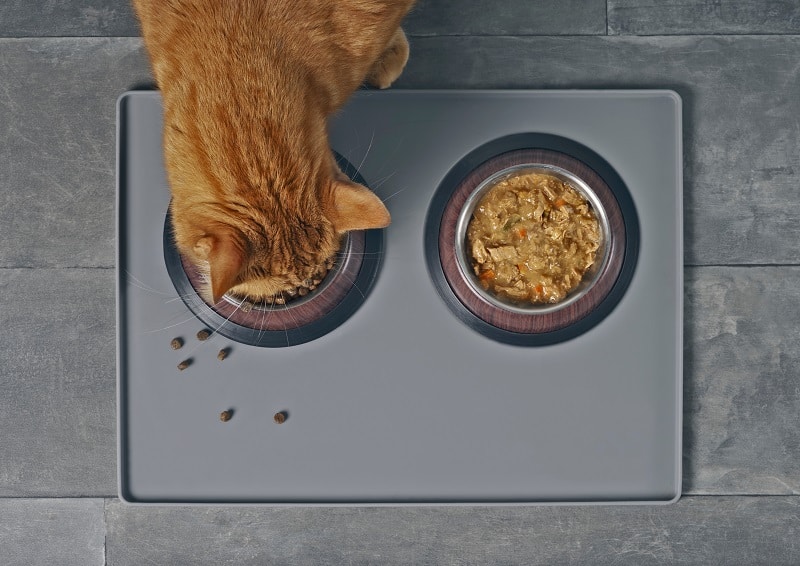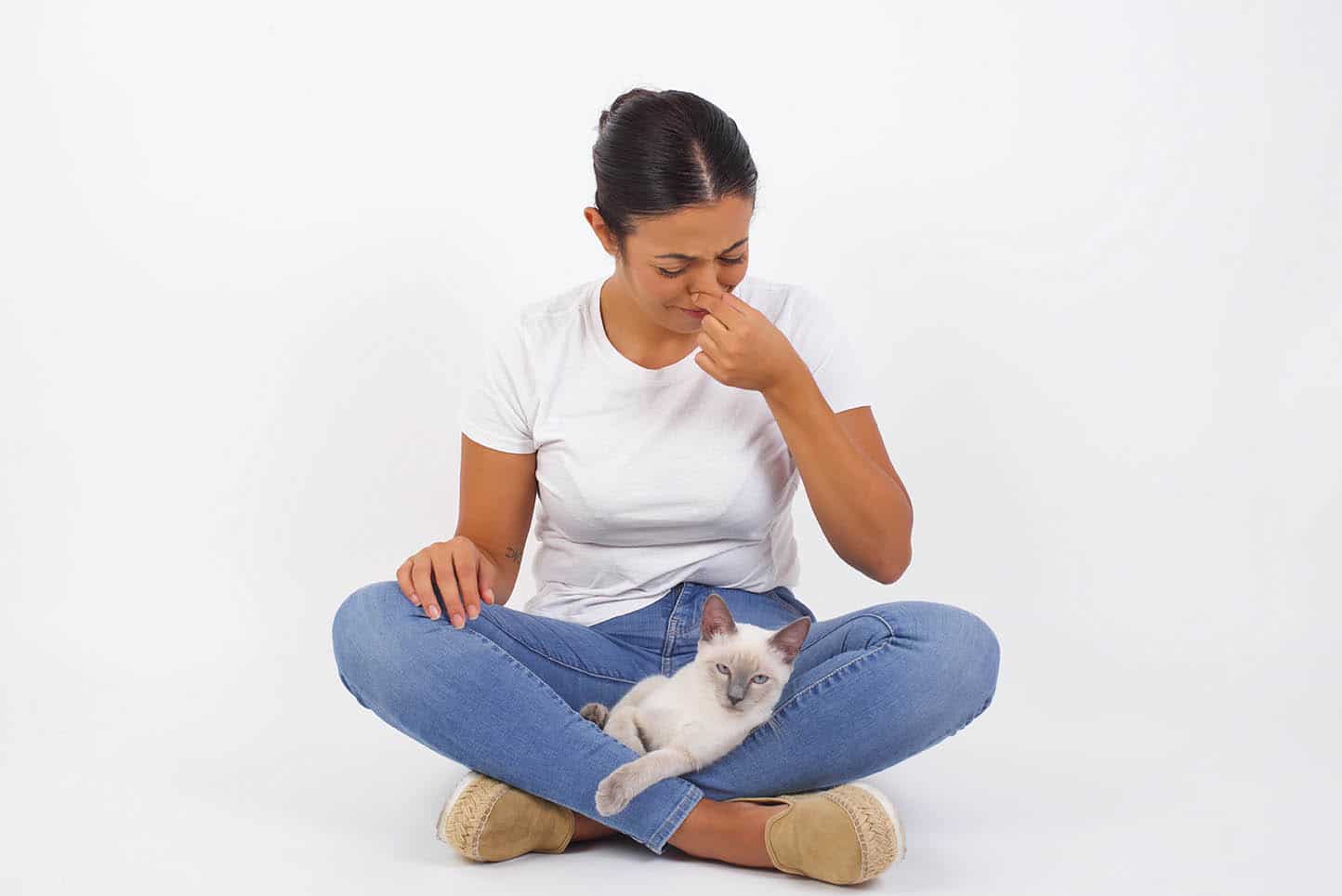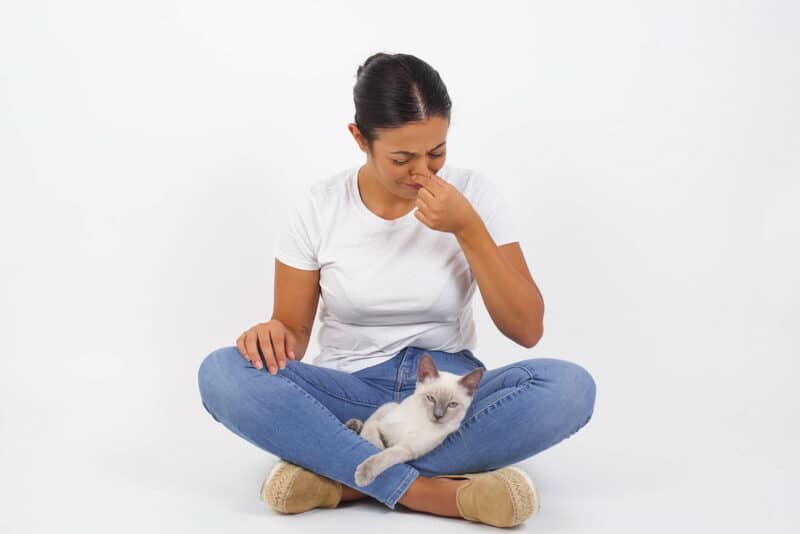There’s almost nothing better than your daily cuddle with your feline friend. One of the big draws of owning a cat is their cleanliness—a trait that cats are known for—but sometimes, you may detect a foul smell coming from your feline, like poop.
Cats are so fastidious about self-grooming, and if your cat suddenly smells like poop, there is a reason for concern. While it is rare that there is something serious at hand, it is still an issue that you’ll want to solve as quickly as possible, both for your and your cat’s sake!
In this article, we’ll discuss five common reasons that your feline may smell like poop and what you can do to fix it!

The 5 Reasons for Your Cat Smelling Like Poop
1. Dirty litter
Litter box maintenance is as essential as any other part of your cat’s maintenance needs, but even with a clean and well-looked-after litter box, your cat may still end up smelling like poop. Some cats, especially kittens, may play inside their litter box, inadvertently spreading feces all over their fur. Additionally, cats instinctually like to cover their waste with litter or sand; in the process, they may get their fur coated in poop. This is especially common in long-haired cats like Persians.
The solution to this problem is fairly simple—you may want to try a self-cleaning, automatic litter box. They reduce the mess caused by cats attempting to bury their poop and are cleaner than traditional boxes. Automated litter boxes can be expensive, and if the price is too high for you, changing to a high-quality litter may also solve the issue.
Even the best cat litter can quickly start smelling bad. To avoid the expense and inconvenience of constantly replacing your litter, you can try a great litter additive like Hepper's Advanced Bio-Enzyme Cat Litter Deodorizer, a natural product that uses bio-enzymes to neutralize odors.
- Bio Enzymatic Cat Litter Freshener - Smart formulation uses natural ingredients eliminating cat...
- Save Money - Stuff for cats isn’t the cheapest. With this litter box odor eliminator, you’ll...
- Every Litter, Every Surface - Are you afraid this additive won’t work on your litter? Fear not!...
This deodorizer works on all types of litter and won't disrupt your cat's litter box habits.
At Catster, we’ve admired Hepper for many years and decided to take a controlling ownership interest so that we could benefit from the outstanding designs of this cool cat company!

2. Dirty cat
While cats are obsessive self-groomers, poop can still get stuck and harden on their coats. This could be caused by runny feces, and if you notice hardened poop around your cat’s rear end, there could be a digestive issue. Additionally, cats that are overweight or have health issues like arthritis may not be able to properly reach parts of their body and adequately groom themselves.
If your cat has matted fur around their rear end, you may need to trim carefully around the area and remove any matted fur. It’s also a great idea to keep the area trimmed to prevent matting later. This will help with overweight or ill cats, but the health issue should still be diagnosed and treated by a vet.
Grooming your pet at home can help you save money and avoid stress, but only if you're armed with a great pet shampoo. We recommend Hepper's Colloidal Oatmeal Pet Shampoo, which has a pH-balanced, pet-safe formula made with natural ingredients like aloe vera and oatmeal. You won't find any irritants like phthalates, sulfates, dyes, or soaps, and the soothing formula will keep your pet's skin moisturized and happy. Plus, the cucumber and aloe scent will make you feel like you've been to the spa! At Catster, we’ve admired Hepper for many years and decided to take a controlling ownership interest so that we could benefit from the outstanding designs of this cool cat company!
3. Change of diet
Cats are obligate carnivores and require a specific diet to stay healthy and happy. A poor diet of too many grains, vegetables, and fruits may cause diarrhea. Additionally, a sudden diet change can cause stomach issues, leading to runny excrement stuck in your cat’s fur.
Feed your feline the best quality food that you can afford, and be sure that it is filled with animal-sourced proteins from fish, beef, and chicken. If you are switching your cat’s regular food to another brand, transition slowly over several days to prevent an upset stomach.

4. Digestive issues
Digestive issues can also cause diarrhea or runny poop that can get caught on your cat’s fur, but they can cause gas too. If your cat smells like poop, but you don’t notice any on their fur, it may just be gas that you’re smelling.
- Dairy products
- Grains like wheat, soy, and corn
- Spoiled foods
- Allergies
- Hairballs
- Gastrointestinal obstructions
Foods with loads of fiber may also be the cause, so check the ingredient list on your cat’s food to ensure it doesn’t contain massive amounts. Avoid giving your cat dairy products and large portions of grains, and avoid any spoiled foods. If all this is in order, they may have an allergy you’ll need a vet to prescribe a healthy diet for.
5. Anal Glands Issues
Cats can be prone to anal gland issues, and if their food and litter box are all in order, they could cause your cat’s foul odor. These scent glands are usually expressed during defecation and territory marking and have a powerful fecal smell. If their anal gland gets clogged, they can develop an infection that may leak or form an abscess, resulting in a foul odor.
If you notice your cat having trouble doing their business and they are showing any signs of discomfort by constantly licking the area, there may be an anal gland issue, and you should take them to the vet as soon as possible.
How to Eliminate the Smell
Combating pet smells begins with eliminating them from the source! Bathing your cat may not always be the answer and luckily, there are products out there that can help keep your pet and home smelling fresh. Our favorite product is the Hepper Pet Cologne in the light Cucumber and Aloe scent. A few spritzes to their coat will help remove lingering odors, smooth and detangle their fur and leave your feline smelling delightful. This vet-approved formula is created with pet-friendly ingredients, free of harsh chemicals and additives. Learn more about it here.
At Catster, we’ve admired Hepper for many years and decided to take a controlling ownership interest so that we could benefit from the outstanding designs of this cool cat company!
Chances are fairly low that your cat suffers from an anal infection, so the smell is most likely from matted fur or a messy litter box. In that case, a bath is the first order of business! Check your cat’s fur for any traces of poop that may be stuck, and check their litter box for signs of diarrhea. If your cat’s stool is normal, you’ll probably just need to switch to a self-cleaning litterbox or high-quality litter and keep the area around their rear end short and trimmed.
If you’ve eliminated all these factors and the problem persists, you should visit the vet for further investigation.
Final Thoughts
If your cat suddenly smells like poop, there is usually no reason to panic. The cause and solution are usually simple; after a good bath, your cat will smell fresh again in no time! If your cat’s diet and litter box are normal and unchanged, there may be a more severe issue at hand, but that is relatively rare.
See Also:
Featured Photo Credit: Jihan Nafiaa Zahri, Shutterstock














